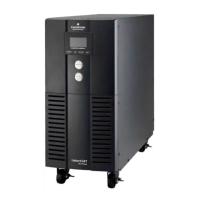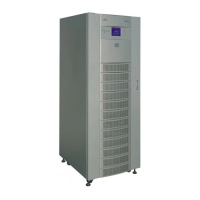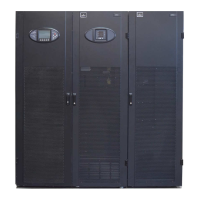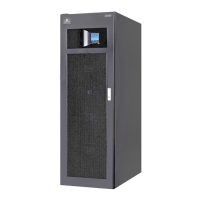Chapter 3 Parallel UPS Installation And Commissioning 35
Liebert
®
ITA 16kVA And 20kVA UPS User Manual
tested will enter bypass state. Because the POD output MCB of the other UPS is not closed, the Input Disconnect
Fault will be displayed, and Bypass unable to trace or Bypass protection may occur, ignore these alarms at the
moment.
3) After the rectifier has been in normal operation state for about 30 seconds, the rectifier start-up is finished.
4) Refer to 3.5.2 Parallel UPS Parameters Setting for the parallel parameters setting for each UPS. Note whether
there is a ‘Parallel comm. Fail’ alarm, if yes, clear the fault according to Table 4-8. Carry out the following procedures
if the UPS is running normally.
5) Press the ON button of one UPS for 2 seconds, if 1 + 1 parallel POD is configured, press the ON button of the
UPS which is being tested in the parallel system, the inverter indicator (green) will blink, after 20 seconds, the inverter
will start, and the inverter indicator will turn on, if 1 + 1 parallel POD is configured, the other UPS will display no power,
ignore the prompt at the moment.
6) If the battery is not connected, the fault indicator will blink. If the battery is connected, the fault indicator will turn off.
7) If the UPS is working normally, press the OFF key for two seconds to turn off the inverter.
8) Repeat the preceding step1) ~ setp7) to power on and commission the inverter of other UPSs respectively.
Note
Carry out the parallel commissioning after each UPS is working normally.
2. After confirming that the inverter of each UPS is normal, commission the parallel system, the specific procedures
are as follows:
1) Close the external output MCB and input MCB of each UPS, and all UPSs are powered on at the same time and
enter the bypass mode. After the start of the rectifier is finished, press the ON key of one UPS for two seconds, the
inverter indicator (green) will be on. Measure whether the inverter output voltage is normal. If the 1 + 1 parallel POD
is configured, close the corresponding input MCB, bypass MCB and output MCB of the POD.
2) Start the inverter of the second UPS, check whether there is a alarm on the LCD, and confirm that the UPS parallel
works normally.
3) Follow the methods to start the inverter of the third or the fourth UPS to connect the UPS into the parallel system.
Warnng
1. During the parallel power-on, confirm that the extenal output MCB of each UPS has been closed, and that all the inverter
output of the UPSs are connnted parallelly.
2. During the parallel power-on, confirm that the system is working normally, and then feed power to the load, to void load power
failure.
3.6 Installation And Commissioning For Double Bus System
3.6.1 Introduction
The double bus system consists of two independent UPS systems; each UPS system consists of one or two
parallel-connected single UPSs, or more parallel-connected single UPSs.
The double bus system has high reliability, which is suitable for the load with many input terminals. For single UPS
input load, you can add a static trigger switch (STS, optional) to start the standard Load Bus Synchronization (LBS)
system.
Place the UPSs side by side, and connect the UPSs as follows:
The double bus system uses the LBS system to realize the output synchronization of the two independent (or parallel)
UPS systems. One is the master system, and the other is the slave system. The operation mode of the double bus
system contains master system and/or slave system running in Normal mode or Bypass mode. The schematic
diagram of the LBS system built by 1 + 1 parallel system is shown in Figure 3-9.
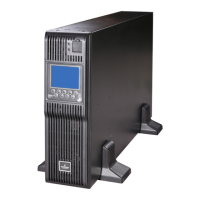
